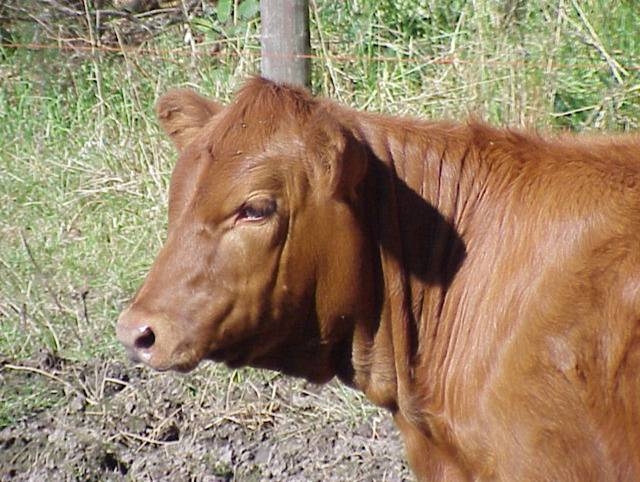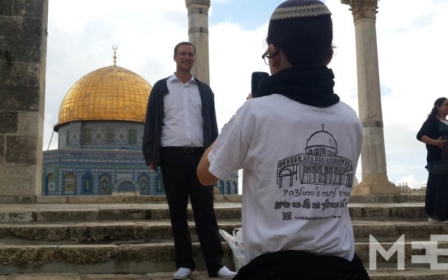Rabbi’s miracle cow threatens ‘apocalypse’ at al-Aqsa

Jerusalem - In his Jerusalem office, Rabbi Chaim Richman has steeped himself in an unlikely mix of 2,000-year-old Judaic tradition and the latest in American cattle-breeding technology.
His aim is to genetically engineer a perfect red heifer. If he succeeds, he believes it will open the way to destroying one of the holiest sites in Islam – the al-Aqsa mosque in Jerusalem’s Old City – and building a Jewish temple in its place.
The plan has the potential to set the Middle East on fire.
The Temple Institute, of which Richman is the international director, was established in the late 1980s with the goal of recreating a Jerusalem temple destroyed by the Romans nearly two millennia ago.
The ruins, and those of an earlier temple, are believed to lie beneath the mosque. As a result, Jews refer to the al-Aqsa compound as Temple Mount.
In a promotional video, the rabbi describes his efforts to raise a herd of red cows as an “unprecedented historical project”. He says: “For 2,000 years, we’ve been mourning the destruction of the holy temple, but the future is in our hands.
“The challenge is to raise a perfect red heifer according to the exact Biblical requirements here in the land of Israel. It’s time to stop waiting and start doing.”
The institute, which was once considered an extremist fringe group, has found an increasingly supportive audience among Jewish settlers and American Christian Zionists.
Over the past decade its ideas have also entered the Israeli mainstream: politicians, including government ministers, echo its language about a third temple, and education ministry funding exposes tens of thousands of Israeli pupils each year to its agenda.
Palestinian concerns about a growing threat to al-Aqsa have underpinned weeks of clashes with Israeli security forces and triggered a spate of so-called “lone-wolf” attacks.
Israeli experts who have studied the Temple groups agree that Palestinians are right to be worried. They warn that the ambitions of figures like Rabbi Richman could bring about an “apocalypse” in the region.
2,000-year wait
The Temple Institute’s plans for a third temple, however, will remain stuck on the drawing board unless it can find a completely red heifer – one that does not have any white or black hairs.
One of several Biblical references to the red heifer occurs in the Book of Numbers, in which God tells Moses: “Speak unto the children of Israel, that they bring thee a red heifer without spot, wherein is no blemish, and upon which never came yoke.”
Moses is instructed to ritually sacrifice the animal and mix its ashes with cedar wood and hyssop. The high priest must then bathe in the mixture for the “purification of sin”.
Later Jewish scholars extended this cleansing ritual to the priestly caste that served in the earlier Jerusalem temples, the first built by King Solomon and the second that stood for hundreds of years before its destruction in 70AD.
In Jewish tradition, a pure red heifer has not been seen since the Second Temple period 2,000 years ago.
For decades, Temple Mount activists have scoured herds of red cattle around the globe, from Argentina to New Zealand, to find one, but without success.
Now, with cattle-breeding technology making rapid advances, Richman claims it is possible to create such a heifer through genetic selection and insemination techniques.
He has partnered with a farm in Israel’s south that has recently begun breeding Angus Red cattle prized for their meat, using frozen embryos imported from the US.
Christian Zionist help
After releasing their brief promotional campaign last summer, Richman and other Temple Institute staff are now refusing to talk to the media.
The institute appears to have come under pressure to keep a low profile from US donors who originally introduced a programme to develop Israel’s beef industry on ranches in the Negev.
It is the farmers’ expertise Richman depends on to engineer a red heifer, but US investors have been embarrassed by the publicity.
A source close to the institute told Middle East Eye that efforts to breed a pure red cow were “quietly advancing” as its staff and Israeli farmers gained greater knowledge of cattle-breeding techniques.
“Nothing will be revealed until we announce we have a found candidate [heifer], and that may be a year or two away,” said the source. “The issue is very sensitive at the moment.”
Richman returned this week from a trip to the US, after what is believed to have been an attempt to raise additional funds, including from Christian Zionist organisations. The Christian Zionist movement in the US is estimated to have tens of millions of followers.
Israeli scholar Gershom Gorenberg notes in his book The End of Days that many Christian Zionists believe that the rebuilding of the temple is “an essential condition for the Second Coming”.
No longer on fringes
According to a survey last year by the Israel Democracy Institute, 38 per cent of Israeli Jews support praying on the Temple Mount, despite the prohibitions of the Chief Rabbinate. Another poll, conducted in 2013, showed a third of Israeli Jews backed rebuilding the temple.
Yossi Gurvitz, an Israeli journalist and researcher on Temple groups, said surveys 20 years ago showed only a handful of Israelis supported such ideas. “The days are over when these groups can be seen as an insane and irrelevant element in Israeli society.”
An investigation by the daily Haaretz last month revealed that the Temple Institute had received more then $560,000 from various government ministries over the past five years. Much of it came from the education ministry. Mandatory classes in state religious schools on “Love of the Land and Temple” instruct pupils to “pray from the bottom of my heart for the Temple to be rebuilt”.
Gurvitz noted that the Temple Institute is also included as a “national service” alternative to Israel’s compulsory military draft for young religious women.
Tours for schoolchildren
Ofer Zalzberg, an Israeli researcher for the International Crisis Group, a conflict resolution think-tank based in Washington and Brussels, said the institute had used state funding to bring as many as 60,000 Israeli pupils on Temple Mount tours each year.
“The pupils are effectively obliged to attend these tours, and there they hear very different things than they would be told by their own rabbis,” he told MEE.
Zalzberg, who recently published a report on the changing status at the Temple Mount, estimates that only one in 100 rabbis share Richman’s view that Jewish activists should seize the initiative in rebuilding the Temple Mount, rather than await God’s plan.
“The problem is that the Israeli government says it is committed to the status quo [protecting Islamic authority over al-Aqsa] but it is educating the next generation to think they can change that status quo.”
Government ministers have contributed to the growing centrality of the Temple Mount in Israeli discourse. Agriculture Minister Uri Ariel, of the settler Jewish Home party, has called for the temple to be rebuilt.
Temple activism is also gaining ground rapidly in Netanyahu’s ruling Likud party. Tzipi Hotovely, the deputy foreign minister, recently said her “dream” was to see the Israeli flag flying on the Temple Mount.
Gurvitz noted that Israel’s intelligence services regularly uncovered plots by Temple Mount activists to blow up al-Aqsa. “It’s only a matter of time until one of them succeed,” he said. “Their vision of the future is apocalyptic.”
Priestly council revived
Until recently, almost all rabbis banned visits by Jews to the al-Aqsa compound, fearing that, without ritual purification, they would defile the site. That injunction has significantly weakened over time, with many nationalist rabbis now backing access.
But the Temple Institute has bigger ambitions.
Its founder, Rabbi Yisrael Ariel, heads a body called the “Nascent Sanhedrin,” a council of Jewish sages established in 2004 to revive a priestly caste from the Second Temple period.
Its members include leading religious figures, such as the revered Talmudic scholar Adin Steinsaltz and a distinguished professor, Hillel Weiss.
In addition, the Temple Institute has drawn up blueprints for the temple, trained four priests, recreated their holy garments, crafted religious implements and designed the altars.
The stumbling block has been the need for a sacrificial red heifer. No priests can enter the temple until they are purified by its ashes.
Embryos imported from US
Richman’s chance to move ahead came only when Israel’s agriculture ministry partially lifted a ban on imports of cattle from the US designed to prevent the spread of mad cow disease.
Ranches in the Negev began importing embryos of Red Angus cattle two years ago to help improve Israel’s beef industry, said Yaacov Moscovitz, director of the Ramat Negev Desert AgroResearch and Business Centre.
He would not comment on whether his centre was assisting the institute’s red heifer programme.
Richman is reported to have persuaded one rancher, Moshe Tenne, to provide a live video feed from his cattle sheds to the institute’s offices in Jerusalem to ensure the cows are being raised in the right conditions.
A promotional video shows the institute’s rabbis inspecting the cattle on his ranch with a magnifying glass for imperfections.
However, according to the Haaretz newspaper, the Temple Institute may face a Catch-22. According to Jewish law: “The red heifer must be ritually slaughtered by a cohen [priest] who is ritually pure himself – and due to the lack of red heifer ashes, such a cohen does not exist.”
New MEE newsletter: Jerusalem Dispatch
Sign up to get the latest insights and analysis on Israel-Palestine, alongside Turkey Unpacked and other MEE newsletters
Middle East Eye delivers independent and unrivalled coverage and analysis of the Middle East, North Africa and beyond. To learn more about republishing this content and the associated fees, please fill out this form. More about MEE can be found here.




